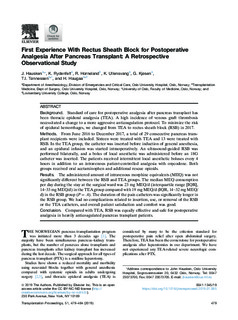| dc.contributor.author | Hausken, John | |
| dc.contributor.author | Rydenfelt, Kristina Elisabeth | |
| dc.contributor.author | Horneland, Rune | |
| dc.contributor.author | Ullensvang, Kyrre | |
| dc.contributor.author | Kjøsen, Gisle | |
| dc.contributor.author | Tønnessen, Tor Inge | |
| dc.contributor.author | Haugaa, Håkon | |
| dc.date.accessioned | 2020-01-15T09:48:26Z | |
| dc.date.available | 2020-01-15T09:48:26Z | |
| dc.date.created | 2019-06-11T11:30:48Z | |
| dc.date.issued | 2019 | |
| dc.identifier.citation | Transplantation Proceedings. 2019, 51 (2), 479-484. | nb_NO |
| dc.identifier.issn | 0041-1345 | |
| dc.identifier.uri | http://hdl.handle.net/11250/2636360 | |
| dc.description.abstract | Background
Standard of care for postoperative analgesia after pancreas transplant has been thoracic epidural analgesia (TEA). A high incidence of venous graft thrombosis necessitated a change to a more aggressive anticoagulation protocol. To minimize the risk of epidural hemorrhages, we changed from TEA to rectus sheath block (RSB) in 2017.
Methods
From June 2016 to December 2017, a total of 29 consecutive pancreas transplant recipients were included. Sixteen were treated with TEA and 13 were treated with RSB. In the TEA group, the catheter was inserted before induction of general anesthesia, and an epidural infusion was started intraoperatively. An ultrasound-guided RSB was performed bilaterally, and a bolus of local anesthetic was administered before an 18G catheter was inserted. The patients received intermittent local anesthetic boluses every 4 hours in addition to an intravenous patient-controlled analgesia with oxycodone. Both groups received oral acetaminophen and additional rescue opioids.
Results
The administered amount of intravenous morphine equivalents (MEQ) was not significantly different between the RSB and TEA groups. The median MEQ consumption per day during the stay at the surgical ward was 23 mg MEQ/d (interquartile range [IQR], 14–33 mg MEQ/d) in the TEA group compared with 19 mg MEQ/d (IQR, 14–32 mg MEQ/d) in the RSB group (P = .4). The duration of the pain catheters was significantly longer in the RSB group. We had no complications related to insertion, use, or removal of the RSB or the TEA catheters, and overall patient satisfaction and comfort was good.
Conclusion
Compared with TEA, RSB was equally effective and safe for postoperative analgesia in heavily anticoagulated pancreas transplant patients. | nb_NO |
| dc.language.iso | eng | nb_NO |
| dc.rights | Attribution-NonCommercial-NoDerivatives 4.0 Internasjonal | * |
| dc.rights.uri | http://creativecommons.org/licenses/by-nc-nd/4.0/deed.no | * |
| dc.subject | Transplantasjon | nb_NO |
| dc.subject | Analgesi | nb_NO |
| dc.title | First Experience With Rectus Sheath Block for Postoperative Analgesia After Pancreas Transplant: A Retrospective Observational Study | nb_NO |
| dc.type | Journal article | nb_NO |
| dc.type | Peer reviewed | nb_NO |
| dc.description.version | publishedVersion | nb_NO |
| dc.source.pagenumber | 479-484 | nb_NO |
| dc.source.volume | 51 | nb_NO |
| dc.source.journal | Transplantation Proceedings | nb_NO |
| dc.source.issue | 2 | nb_NO |
| dc.identifier.doi | 10.1016/j.transproceed.2019.01.065 | |
| dc.identifier.cristin | 1703925 | |
| cristin.unitcode | 230,0,0,0 | |
| cristin.unitname | Lovisenberg diakonale høgskole | |
| cristin.ispublished | true | |
| cristin.fulltext | original | |
| cristin.qualitycode | 1 | |

